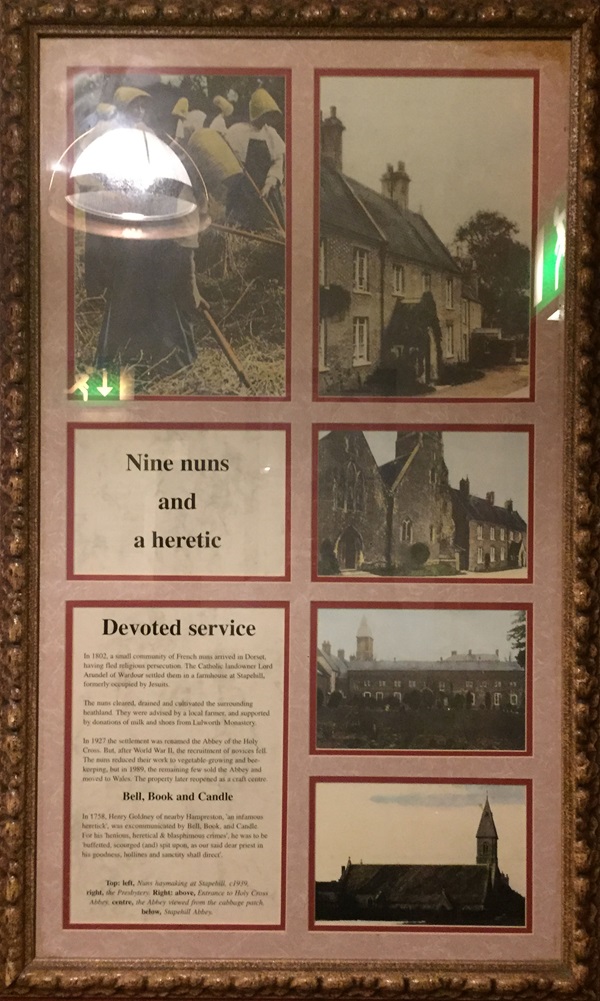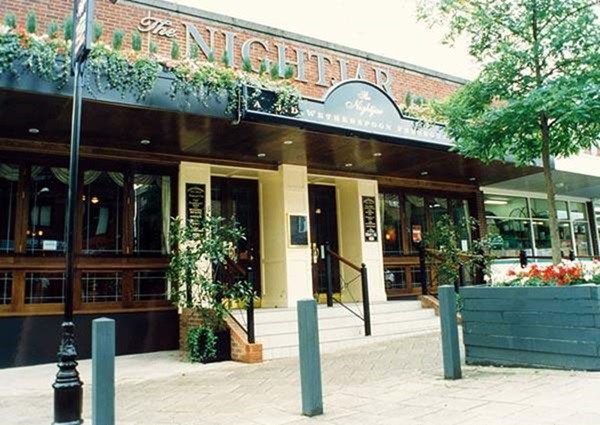This pub takes its name from one of the species of bird which inhabits the surrounding heathland. Nightjars spend the winter in Africa, arriving here in May and leaving again in October. Their attractive name is derived from their nocturnal ‘churring’ or ‘jarring’ call. Ferndown is situated in what is called the Poole Basin Heathlands, a wildlife habitat for many rare plants and animals and home to all six native British reptiles, including most of the country’s smooth snakes and sand lizards.
Prints and text about the arrival of the railway.

The text reads: In May 1844 Charles Castleman, a Wimborne solicitor, called a public meeting to form the Southampton & Dorchester Railway Company. Parliamentary consent was granted a year later, and construction of the line was completed in May 1847.
However, two days before the planned opening ceremony, the collapse of part of a tunnel blocked the through route. Celebrations went ahead in spite of the disaster, and full services began in August.
The route, which took in Brokenhurst, Holmsley, Ringwood, Wimborne, and Broadstone, was fairly torturous, and led to the popular nickname of Castleman’s Corkscrew.
This was one of the factors that prevented it becoming part of the main route to the west, as Charles Castleman had originally intended.
Passengers for Ferndown had to wait twenty years for the building of a station nearer then Wimborne or Ringwood. West Moors for Ferndown opened near a junction with the newly-built line from Salisbury.
This connection to the railway network was a key element in the development of Victorian Ferndown.
Left: above, Station Road, West Moors, below, West Moors for Ferndown
Above: A sedate alternative to the railway – local deliveries.
Prints and text about abbeys in Ferndown.

The text reads: In 1802, a small community of French nuns arrived in Dorset, having fled religious persecution. The Catholic landowner Lord Arundel of Wardour settled them in a farmhouse at Stapehill, formerly occupied by Jesuits.
The nuns cleared, drained and cultivated the surrounding heathland. They were advised by a local farmer, and supported by donations of milk and shoes from Lulworth Monastery.
In 1927 the settlement was renamed the Abbey of the Holy Cross. But after World War II, the recruitment of novices fell. The nuns reduced their work to vegetable growing and beekeeping, but in 1989, the remaining few sold the Abbey and moved to Wales. The property later reopened as a craft centre.
In 1758, Henry Goldney of nearby Hampreston, an infamous heretic, was excommunicated by Bell, Book and Candle. For his heinous, heretical and blasphemous crimes, he was to be ‘buffeted, scourged and spit upon, as our said dear priest in his goodness, holiness and sanctity shall direct’.
Top: left, nuns haymaking at Staplehill, c1939, right, the presbytery
Right: above, entrance to Holy Cross Abbey, centre, the Abbey viewed from the cabbage patch, below, Staplehill Abbey.
A photograph of Ringwood Road, Ferndown, c1920.

External photograph of the building – main entrance.

If you have information on the history of this pub, then we’d like you to share it with us. Please e-mail all information to: pubhistories@jdwetherspoon.co.uk